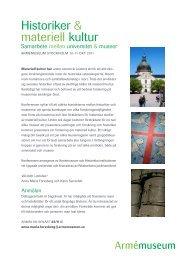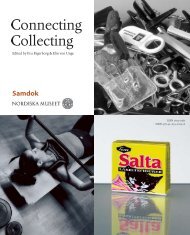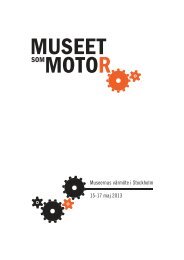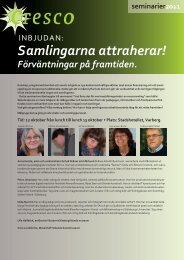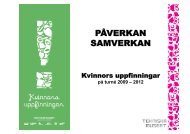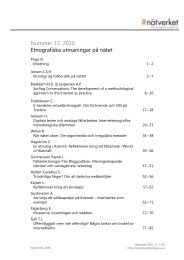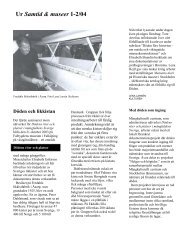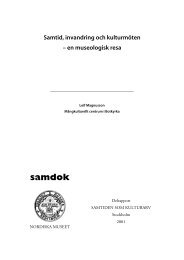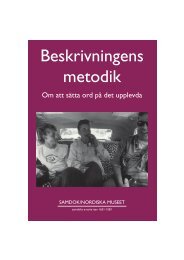Connecting Collecting - Sveriges Museer
Connecting Collecting - Sveriges Museer
Connecting Collecting - Sveriges Museer
Create successful ePaper yourself
Turn your PDF publications into a flip-book with our unique Google optimized e-Paper software.
The Cultural Encounters GroupIt is time for diversity in Sweden. Cultural encounters and migrationare highly topical issues in society, and hence for museums too.The Cultural Encounters Group focuses on how the cultural encountersperspective is applied in the practical work.Updating SwedenBy Leif Magnussoncontemporary perspectives on»The situation analysis publishedby the National Council for CulturalAffairs in 2005 shows that museumsin general have both the readinessand the ambition to work with the diversityissue. In the appendix to the analysisit is noted that the museums tackle thistask in a great variety of ways. The focuscan be on the position of national minorities,on cultural phenomena connectedwith immigration or its consequences.International contacts also seem to beincreasing as a result of European integrationor via the interest in nationalmuseum collections around the world.On the other hand, it is more unusualthat museums in their exhibitions reflecton the fact that cultural encountersare a natural ingredient in all cultures, orthat the museums consider how the collectionsexemplify this.Similar ideas can be found in myarticle on “Immigration, Cultural Encounters,Ethnicity” in Samtiden somkulturarv. Svenska museers samtidsdokumentation1975–2000. (2006). Themuseums that were working with theissue then mainly focused on a kind ofmonographic perspective intended tosingle out ethnic groups and immigrantgroups. This tendency to search for distinctionshas been criticized, and thereis a constant quest for more dynamicmodels. This is very important, since oursociety has to balance the pressure ofglobalization, both the positive and thenegative consequences. If increased mobilityfor people, knowledge, and moneyis allowed to represent the good side ofglobalization, there is a bad side thatclearly involves the social and culturalissues.A harsher social climateWhat does this negative side consist of?If we look at our neighbours Denmarkand Norway, we see that the politicalmap has been redrawn in order topreserve the national community whenthe global pressure has squeezed thestrength out of the national power structures.One effect of this is that pressureincreases on the definitions of people’sstatus. Who belongs to the nationalcommunity? When can one join, andhow? Individuals are far too simply andlightly assigned to ethnic categories,which risks creating second-class citizensin the Nordic societies. The problemalso exists in Sweden, but here it ishandled differently because – comparedto our Nordic neighbours – we havereacted more weakly to the counterreactionthat globalization creates in anynation state. However, in Sweden thereis no shortage of signs of a harsher socialclimate as regards diversity.Museums that work with the presentday as cultural history are dependenton the prevailing climate of politicalopinion. When we in the Cultural EncountersGroup write in our action programmethat our work has a clear orientationto cultural policy, through theoutlook that “documenting the presentat Swedish museums is about seeingcultural encounters and migration as anindissoluble part of Sweden’s culturalhistory and social life”, we see the workin a broader context. That is our point ofdeparture.More than ethnicityThe cultural encounter perspective as atheoretical point of departure has beendiscussed since the group was foundedin 1993. The discussion has been livelyand has had the result that the group’sprogramme has been revised severaltimes. Museums which have taken partin the work over the years have had differentpurposes and goals for their participation.There has been a willingnessto bring in issues that have the emphasison other power factors than ethnicitywhen it comes to describing migrationand links to origin and place. Power factorssuch as gender, generation, sexuality,and class are always considered automaticallywhen studies are performed.It is easy enough to write this, but it isa tricky task, requiring competent andwell-trained staff. The ongoing discussionin the Cultural Encounters Group isintended to test and identify research inthe field of International Migration andEthnic Relations (IMER), post-colonialism,and the museological discussion6 • Samtid & museer no 2/07



